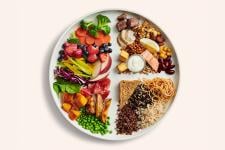Healthy eating is a habit. Eat vegetables and fruits, whole grain foods and protein foods as part of a healthy eating pattern to maintain your health.
Benefits of healthy eating patterns
Making healthy food choices can help you develop a healthy eating pattern. A healthy eating pattern helps you improve your overall health.
The term eating pattern refers to what you eat and drink on a regular basis. In a healthy eating pattern, all the foods and drinks work together to:
- help you feel good
- maintain your health
- meet your nutritional needs
Many of the well-studied healthy eating patterns include mostly plant-based foods.
Plant-based foods can include:
- vegetables and fruits
- whole grain foods
- plant-based protein foods
Eating plant-based foods regularly can mean eating more fibre and less saturated fat. This can have a positive effect on health, including a lowered risk of:
- cancer
- heart disease
- type 2 diabetes
Most healthy eating patterns include few or no highly processed foods.
How to develop a healthy eating pattern
You can develop a healthy eating pattern by:
- Eating more vegetables and fruits, especially those that are:
- dark green such as broccoli and bok choy
- orange such as carrots and sweet potato
- Selecting whole grain varieties of grain foods such as:
- whole grain pasta
- whole grain bread
- whole oats or oatmeal
- whole grain brown or wild rice
- Replacing dairy products that are higher in saturated fat, sodium, and sugars with healthier varieties such as:
- lower fat unsweetened yogurt
- lower fat and lower sodium cheeses
- lower fat white milk and unsweetened plant-based beverages
- Replacing meats higher in saturated fat with leaner varieties such as:
- eggs
- wild game
- skinless poultry
- fish and shellfish
- Replacing some of the meat in your meals with plant-based protein foods such as:
- tofu
- nuts
- seeds
- legumes
- Limiting highly processed foods such as:
- preserves like jams and jellies
- desserts like ice cream and chocolates
- salty snacks like potato chips and pretzels
- processed meats like bacon and sausages
- sugars and syrups like honey and molasses
- bakery products like cookies and croissants
- sauces, dressings, dips, gravies and condiments
- sugary drinks like juice and sweetened coffee and tea
The best healthy eating patterns include foods that reflect your food choices related to:
- taste
- culture
- budget
- lifestyle
Make a healthy choice
What you eat on a regular basis matters for your health.
- Choose foods that have little to no added sodium, sugars or saturated fat.
- Compare the nutrition facts table on foods to choose products that are lower in sodium, sugars or saturated fat.
- Date modified:


